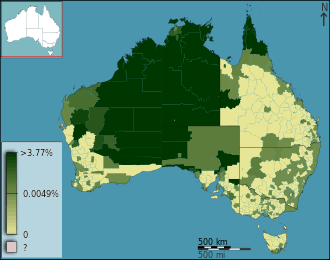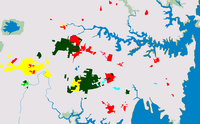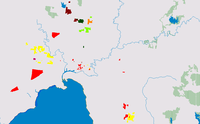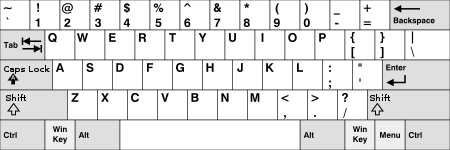Languages of Australia
| Languages of Australia | |
|---|---|
| Main languages | Australian English |
| Indigenous languages | Australian Aboriginal languages, Tasmanian languages, Torres Strait Island languages |
| Main immigrant languages | Mandarin (2.5%), Arabic (1.4%), Cantonese (1.2%), Vietnamese (1.2%), Italian (1.2%) |
| Sign languages |
Auslan Yolŋu Sign Language and other Aboriginal sign languages |
| Common keyboard layouts | |
Although Australia has no official languages, English has been entrenched as the de facto national language since European invasion.[1] Australian English is a major variety of the language with a distinctive accent and lexicon,[2] and differs slightly from other varieties of English in grammar and spelling.[3] General Australian serves as the standard dialect.
According to the 2016 census, English is the only language spoken in the home for close to 73% of the population. The next most common languages spoken at home are:[4] Mandarin (2.5%), Arabic (1.4%), Cantonese (1.2%), Vietnamese (1.2%) and Italian (1.2%).
A considerable proportion of first- and second-generation migrants are bilingual.
Over 250 Indigenous Australian languages are thought to have existed at the time of first European contact, of which less than 20 are still in daily use by all age groups.[5][6] About 110 others are spoken exclusively by older people.[6] At the time of the 2006 census, 52,000 Indigenous Australians, representing 12% of the Indigenous population, reported that they spoke an Indigenous language at home.[7] Australia has a sign language known as Auslan, which is the main language of about 5,500 deaf people.[8]
Australian Aboriginal languages
It is believed that there were almost 400 Australian Aboriginal languages at the time of first European contact. Most of these are now either extinct or moribund, with only about fifteen languages still being spoken among all age groups of the relevant tribes.[9]
An indigenous language remains the main language for about 50,000 (0.25%) people. Australia has a sign language known as Auslan, which is the main language that approximately 10,000 deaf people use. Chinese is by far the most spoken foreign language, with 715,000 speakers as of 2016, and has even been considered to be put on signs across Australia, to encourage tourists to explore and interact with other people.

The Aboriginal languages with the most speakers today are Upper Arrernte, Kalaw Lagaw Ya, Tiwi, Walmajarri, Warlpiri, and the Western Desert language.
Tasmanian languages
Torres Strait languages
Two languages are spoken on the islands of the Torres Strait, within Australian territory, by the Melanesian inhabitants of the area: Kalaw Lagaw Ya and Meriam. Meriam Mir is a Papuan language, while Kalaw Lagaw Ya is an Australian language.
Pidgins and creoles
Two English-based creoles have arisen in Australia after European contact: Kriol and Torres Strait Creole. Kriol is spoken in the Northern Territory and Western Australia, and Torres Strait Creole in Queensland.
Broome Pearling Lugger Pidgin was a pidgin used as a lingua franca between Malays, Japanese, Vietnamese, Torres Strait Islanders and Aborigines on pearling boats.
Immigrant languages
There has been a steady decline in the percentage of Australians who speak only English at home since at least 2001. According to the 2001 census, English was the only language spoken in the home for around 80% of the population. By the 2006 census it had fallen to close to 79%, while in the 2011 census, that number had fallen to 76.8%. According to the 2016 census, English is the only language spoken in the home for close to 72.7% of the population. The next most common languages spoken at home are:[10]
- Mandarin (2.5%)
- Arabic (1.4%)
- Cantonese (1.2%)
- Vietnamese (1.2%)
- Italian (1.2%).
A considerable proportion of first- and second-generation migrants are bilingual.


See also
References
- ↑ "Pluralist Nations: Pluralist Language Policies?". 1995 Global Cultural Diversity Conference Proceedings, Sydney. Department of Social Services. Archived from the original on 20 December 2008. Retrieved 10 July 2017. "English has no de jure status but it is so entrenched as the common language that it is de facto the official language as well as the national language."
- ↑ Moore, Bruce. "The Vocabulary Of Australian English" (PDF). National Museum of Australia. Archived from the original (PDF) on 20 March 2011. Retrieved 5 April 2010.
- ↑ "The Macquarie Dictionary", Fourth Edition. The Macquarie Library Pty Ltd, 2005.
- ↑ "Archived copy". Archived from the original on 9 July 2017. Retrieved 11 July 2017.
- ↑ "A mission to save indigenous languages". Australian Geographic. Archived from the original on 24 December 2013. Retrieved 18 March 2016.
- 1 2 "National Indigenous Languages Survey Report 2005". Department of Communications, Information Technology and the Arts. Archived from the original (PDF) on 9 July 2009. Retrieved 5 September 2009.
- ↑ Australian Bureau of Statistics (4 May 2010). "4713.0 – Population Characteristics, Aboriginal and Torres Strait Islander Australians, 2006". Canberra: Australian Bureau of Statistics. Retrieved 7 December 2010.
- ↑ Australian Bureau of Statistics (27 June 2007). "20680-Language Spoken at Home (full classification list) by Sex – Australia". 2006 Census Tables : Australia. Canberra: Australian Bureau of Statistics. Retrieved 7 December 2010.
- ↑ McConvell, P. & N.Thieberger. 2001. State of Indigenous Language Report. http://www.environment.gov.au/soe/2001/publications/technical/indigenous-languages.html
- ↑ "Archived copy". Archived from the original on 9 July 2017. Retrieved 11 July 2017.
McConvell, P. & N.Thieberger. 2001. State of Indigenous Language Report .html http://repository.unimelb.edu.au/10187/485
External links
| Wikimedia Commons has media related to Languages of Australia. |

